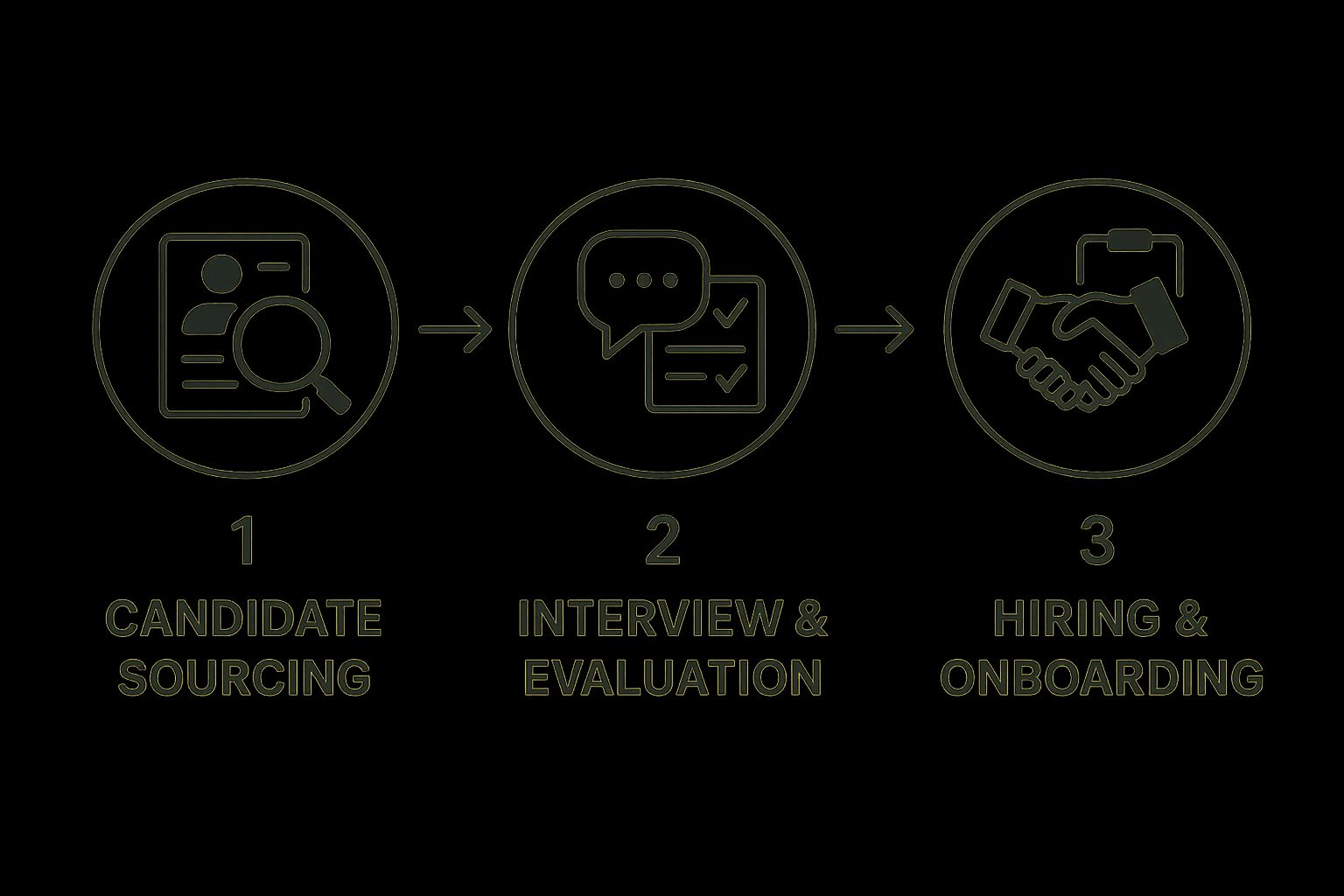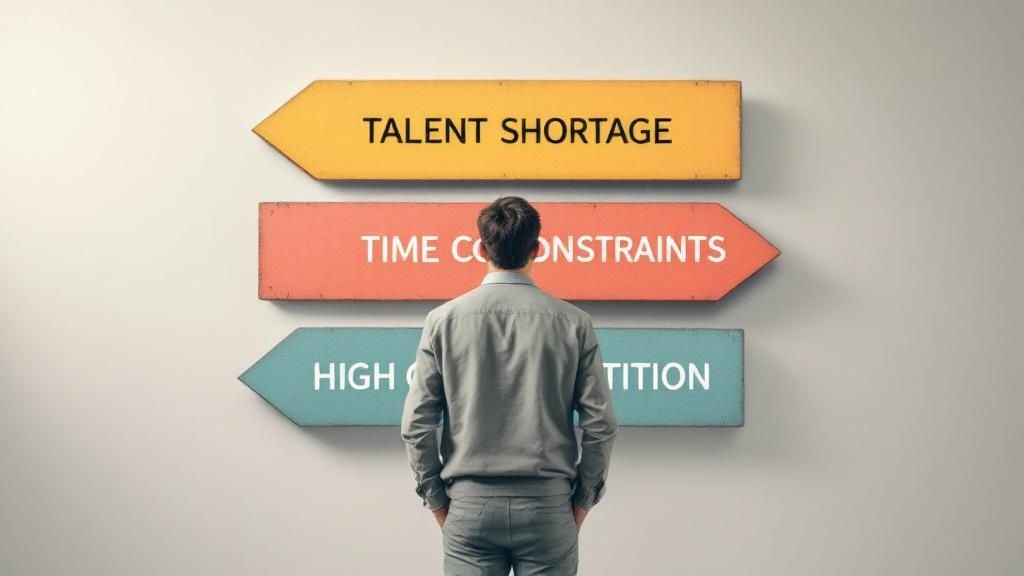August 10, 2025
What Is Full-Cycle Recruiting? Key Insights & Benefits

Full-cycle recruiting isn't just another piece of industry jargon. At its core, it’s about having one person or a small, dedicated team manage the entire hiring process from the moment you identify a need all the way to a new employee’s first day on the job.
Instead of a candidate being passed along an assembly line—from a sourcer to a recruiter to a hiring coordinator—a single, consistent point of contact guides them through the entire journey. This approach makes the whole experience more personal, cohesive, and remarkably efficient.
What Is Full-Cycle Recruiting, Really?

Let’s get practical. Think of a full-cycle recruiter less as a cog in a machine and more as the master architect of your talent acquisition strategy. In a traditional, segmented recruiting model, candidates often feel lost in the shuffle. They might speak with a sourcer, then a recruiter, then someone else for scheduling, creating frustrating delays and mixed messages.
Full-cycle recruiting, sometimes called end-to-end recruiting, completely flips that model. It’s a comprehensive approach where one person owns every single phase of the process. The goal is simple: hire better people, faster. By creating a single thread of communication, you not only shorten the time-to-fill but also dramatically improve the candidate experience. You can find more great insights on how this model works in this overview by Go Perfect.
The Architect Analogy
Imagine you’re building a custom home. Using a fragmented approach, you'd hire a separate architect, contractor, interior designer, and landscaper. They might never even speak to one another, leading to a high risk of miscommunication and a final product that feels disjointed.
Now, picture hiring a single design-build firm. The lead architect from that firm oversees every single step, ensuring the foundation, structure, interiors, and landscaping all work together to achieve a single, cohesive vision. That architect is your full-cycle recruiter. They make sure the candidate you ultimately onboard perfectly aligns with the initial job description, creating a seamless experience from blueprint to move-in day.
This holistic ownership is the core of what makes full-cycle recruiting so powerful. It transforms the hiring process from a transactional series of handoffs into a relationship-building journey, benefiting both the candidate and the company.
This model is a natural fit for startups and smaller businesses where people often have to wear many hats. But it’s not just for small teams. Larger companies are increasingly adopting its principles by creating dedicated recruiting "pods." For instance, a tech company might assign one full-cycle team to handle all engineering hires, giving them the personal touch of a small operation while still managing a high volume of roles.
Full-Cycle vs Specialized Recruiting At a Glance
So, how does this holistic model stack up against a traditional, segmented process? The two offer fundamentally different approaches to finding talent. This quick comparison breaks down the key differences.
Ultimately, full-cycle recruiting is more than just a process—it’s a philosophy. It’s built on the belief that quality connections, clear communication, and end-to-end accountability are the best ways to attract and keep top talent in a fiercely competitive market.
Exploring the Six Stages of Full-Cycle Recruiting
To really get a handle on full-cycle recruiting, it's best to walk through its different stages. Think of it less like a rigid checklist and more like a strategic roadmap that guides a candidate from their first "hello" to their first day. The magic is that success in one stage builds momentum for the next, creating a single, seamless experience for everyone involved.
The full-cycle recruiting model typically has six core stages, starting with planning and ending with a new team member's successful integration. This all-in-one approach is a huge boost to efficiency, cutting out the choppy communication and delays that happen when different people or teams own separate pieces of the hiring puzzle.
If you're curious about how this plays out in the real world, it's worth seeing how top companies structure their hiring processes.
1. Preparation and Role Definition
Everything good in recruiting starts with a solid plan. Before a single job ad goes live, the full-cycle recruiter sits down with the hiring manager to get crystal clear on what success in this new role actually looks like. This conversation goes way beyond a simple list of skills on a job description.
They dig into team dynamics, the specific problems this person will be hired to solve, and what their key achievements should be in the first year. The end result is a detailed, compelling job description that speaks directly to the right person, laying a strong foundation for everything that follows.
2. Proactive Sourcing
With a clear picture of the ideal candidate, the recruiter switches into sourcing mode. This isn't about posting a job and hoping for the best; it's an active, strategic hunt for top talent across multiple channels.
A good sourcing strategy usually involves a mix of tactics:
- Targeted Job Postings: Getting the role in front of the right eyes on niche job boards and professional communities.
- Direct Outreach: Using platforms like LinkedIn to connect with great passive candidates—people who aren't actively looking but are a perfect fit.
- Employee Referrals: Leveraging the networks of current employees, which is often a source of trusted, high-quality talent.
- Talent Pools: Keeping in touch with promising candidates from past searches for future openings.
This infographic breaks down the core workflow from finding candidates to finally hiring them.

As you can see, it’s a fluid process where sourcing, evaluation, and hiring flow right into one another, all guided by that single, dedicated recruiter.
3. Screening and Initial Interviews
Once applications start coming in, the screening begins. The recruiter carefully reviews every resume and application, comparing them against the must-haves defined in the planning stage to create a strong shortlist. From there, they jump into initial phone or video calls.
These first conversations are absolutely critical. They're the first chance to confirm core qualifications, align on salary expectations, and get a real feel for a candidate's personality and what drives them. The goal here is to efficiently narrow the field to a handful of top contenders for the hiring manager to meet.
4. Collaborative Final Selection
At this point, the shortlisted candidates move into deeper interview rounds with the hiring manager and other key members of the team. The full-cycle recruiter’s job here is to act as the ultimate facilitator, making sure the whole process runs like a well-oiled machine.
They handle all the scheduling, prep both the candidate and the interviewers, and might even build in a skills test or case study to see how candidates handle real-world tasks. Afterwards, the recruiter is the one who gathers detailed feedback from everyone involved to drive a smart, data-backed hiring decision.
5. Strategic Offer Management
Once the team has made its choice, the recruiter steps into one of the most delicate phases of all: managing the job offer. This means extending the formal offer and skillfully navigating any negotiations around salary, benefits, or the start date.
This is where the strong relationship they've built throughout the process really pays off. That foundation of trust and open communication makes these conversations smoother and significantly boosts the chances of the offer being accepted.
6. Impactful Onboarding
The recruiter's job doesn't end when the contract is signed. The final stage of true full-cycle recruiting is a well-structured onboarding plan designed to set the new hire up for success from day one.
The recruiter helps smooth this transition, ensuring the new employee's laptop is ready, introductions are made, and they feel genuinely welcomed into the company culture. This final touch makes for a fantastic candidate experience and lays the groundwork for long-term loyalty and retention.
What You Actually Gain From This Model

Shifting to a full-cycle recruiting model is much more than just shuffling around responsibilities. It's a strategic decision that pays off in real, measurable ways. When you put the entire hiring journey into the hands of one person, you don't just get more organized; you unlock serious efficiencies that directly impact your company's growth, speed, and talent quality.
One of the first things you'll notice is how much faster everything moves. Think about a typical, segmented process—it's full of handoffs between different people. A sourcer finds a name, a recruiter makes the first call, and a coordinator tries to line up interviews. Each handoff is a potential delay. Full-cycle recruiting gets rid of those bottlenecks, leading to faster decisions and a nimbleness that lets you snap up great talent before your competitors do.
A Better Experience for Candidates (and a Stronger Brand for You)
In today's market, the candidate experience isn't just a nice extra—it's a critical part of your employer brand. When one recruiter is the single point of contact from that first "hello" to the final job offer, they build a real relationship with the candidate. That personal touch makes people feel seen and valued, which is a massive advantage when top talent has multiple offers on the table.
This positive journey has a direct impact on your offer acceptance rates. Candidates who have a consistent, trusted contact are simply more likely to say "yes" to your company.
A great candidate experience is a natural side effect of the full-cycle model. The trust and rapport built along the way create a powerful advantage that a fragmented, assembly-line process can never match.
And the data backs this up. Companies that embrace full-cycle recruiting often see their time-to-hire drop by a significant 20% to 30%. It’s not just about speed, either. The strong relationships formed during the hiring process can lead to a 15% increase in new hire retention. You can dive deeper and learn how to improve your recruitment process to see similar results.
Higher Quality Hires and Lower Costs
At the end of the day, any hiring strategy is judged by the quality of people it brings in. Because a full-cycle recruiter is involved from the very beginning—helping to define the role itself—they gain a deep, almost intuitive understanding of what it takes to succeed in that position and your company culture.
This holistic view leads to better hires. These are people who not only have the right skills but also fit the team, integrate faster, and are more likely to stick around for the long haul. That alone saves a ton of money on turnover.
This efficiency also hits your bottom line in other ways. A smooth, well-run process reduces administrative waste and often means you rely less on expensive external agencies. This is one of the clearest strategies to reduce recruitment cost per hire. By getting better talent for less money, the full-cycle model gives you a sustainable edge.
Core Skills Every Full-Cycle Recruiter Needs
https://www.youtube.com/embed/0qyk0Ejlr-4
A great full-cycle recruiter is so much more than a sourcer or an interviewer. They're a true strategic partner to the business, and success in this role demands a unique mix of hard and soft skills that go way beyond the basics of hiring.
These pros need to see the entire forest, not just the trees. That means having strong business acumen to grasp how each new hire fits into the company's bigger goals, whether it's hitting revenue targets or launching the next big product. They aren't just filling a vacant seat; they're strategically building the team that drives the company forward.
Strategic and Analytical Skills
A top-tier full-cycle recruiter doesn't just react to open requisitions—they anticipate them. They operate with a strategic mindset, using real data to guide their decisions and, just as importantly, to influence hiring managers. This analytical edge is what makes the entire hiring process smarter, not just faster.
A few key strategic skills really set the best apart:
- Talent Mapping: This is about proactively identifying and keeping tabs on the best talent in your industry, even when you don't have an immediate opening. It’s like building a bench of all-stars so you're always ready to make a move.
- Data-Driven Decision-Making: They live and breathe the metrics. By tracking things like time-to-fill, cost-per-hire, and quality-of-hire, they can pinpoint what's working, what's not, and fine-tune their approach for better results.
- Masterful Negotiation: This is an art form. It's about skillfully handling the offer stage to land the perfect candidate while staying within budget and managing everyone's expectations.
A full-cycle recruiter’s value isn't just about how many roles they fill. It’s measured by the long-term impact of their hires. They are the bridge connecting talent strategy directly to business success.
Interpersonal and Technical Abilities
Strategy is crucial, but the day-to-day execution hinges on outstanding people skills and a solid grasp of technology. These recruiters are relationship-builders at heart, using tech to work more efficiently.
They have to be empathetic interviewers, digging deeper than the rehearsed answers to uncover a candidate’s real motivations and potential. That ability to connect on a human level is what builds trust and creates a genuinely positive experience for the candidate, regardless of the outcome.
On the technical front, being a power user of an Applicant Tracking System (ATS) is table stakes. They also need to be comfortable with modern sourcing tools and platforms. And as technology keeps pushing forward, knowing how to use AI in recruiting is quickly becoming a must-have skill. It allows them to automate the tedious, repetitive work and free up their time for what really matters: engaging with candidates and thinking strategically.
How to Overcome Common Recruiting Challenges

While the full-cycle recruiting model is incredibly effective, it's not a walk in the park. Adopting this approach means being ready for some real hurdles, especially the risk of recruiter burnout and the steep learning curve that comes with wearing so many hats.
The most common headache is, without a doubt, the workload. When a single person is juggling everything from sourcing candidates to getting them onboarded, their pipeline can get clogged fast. This is particularly true when you’re hiring at scale; the constant stream of tasks can easily lead to burnout and a noticeable dip in quality.
The solution isn't about working harder—it's about working smarter. Effective workload management is your best friend here.
Taming the Workload
The best defense against burnout is a mix of strategic focus and smart technology. Start by prioritizing the roles that will make the biggest impact on the business. It’s also crucial to set realistic timelines with hiring managers, which keeps the recruiter from being stretched too thin.
Automation is another game-changer. To manage the flow and handle a high volume of inquiries, many teams now use tools like HR chatbots. These bots can take care of initial screenings, answer frequently asked questions, and even schedule interviews. This frees up your recruiter to focus on what matters most: the human side of hiring.
The goal isn't just to complete tasks, but to build relationships. Effective full-cycle recruiting depends on giving recruiters the time and mental space to connect meaningfully with top candidates.
Closing the Skill Gap
The other big challenge is the sheer breadth of skills required. A full-cycle recruiter has to be a master sourcer, a perceptive interviewer, a savvy negotiator, and a bit of a data geek all rolled into one. That’s a massive skillset for anyone to master.
To tackle this, companies need to invest in ongoing training and professional development. Here’s what that could look like:
- Sourcing Workshops: Keep skills sharp with continuous education. Exploring these 10 candidate sourcing strategies is a great place to start.
- Mentorship Programs: There's no substitute for experience. Pairing new recruiters with seasoned veterans accelerates learning and provides invaluable, on-the-job guidance.
- Tech Enablement: Making sure recruiters are pros at using their ATS and other AI tools like Klearskill isn't just nice to have—it's essential for staying efficient.
By getting ahead of these challenges with smart strategies and the right technology, you can make sure your full-cycle recruiting process remains a powerful engine for growth.
Common Questions About Full-Cycle Recruiting
When leaders and recruiters start digging into the idea of full-cycle recruiting, the same questions tend to pop up. It’s a model that shuffles traditional roles and responsibilities, so it's only natural to wonder how it really works in practice, how you measure its success, and what pitfalls to look out for.
Let's walk through the most common questions to paint a clearer picture of how this approach actually functions in the real world.
Is This Model Only for Small Companies?
This is probably the biggest misconception out there. While full-cycle recruiting feels like a natural fit for startups—where one person often wears all the HR hats anyway—it's definitely not just for them. Plenty of large, complex organizations have figured out how to make its principles work to their advantage.
The trick is in the adaptation. Instead of having a single recruiter handle every open role across the entire company, they get smart and create specialized teams or "pods." For instance, a big global tech company might have a dedicated full-cycle team of two or three recruiters who own the entire hiring process, but only for the Engineering department. Another pod could focus entirely on Sales roles.
This hybrid approach gives you the best of both worlds. You keep the core benefits of the model—like a seamless candidate experience and deep role expertise—while still being able to manage a high volume of hiring. It’s the agility of a startup with the scale of an enterprise.
How Do You Measure a Recruiter's Success?
You can't just count the number of résumés sourced or interviews scheduled. Because a full-cycle recruiter owns the entire process from start to finish, their performance is tied to bigger, more strategic outcomes that show the true quality and efficiency of the whole hiring journey.
The best way to measure success is with a balanced scorecard of a few key performance indicators (KPIs).
- Time-to-Fill: How fast can they get from an open req to an accepted offer? This is a direct measure of their efficiency.
- Quality of Hire: This is the ultimate goal. You can track this through first-year performance reviews, feedback from hiring managers, and—most critically—new hire retention rates after 12 months.
- Offer Acceptance Rate: A high acceptance rate is a great sign. It tells you the recruiter is skilled at building strong relationships, setting realistic expectations, and putting compelling offers on the table.
- Candidate Satisfaction: Sending out post-interview surveys (to everyone, not just the people you hire) gives you priceless feedback on the experience, which is crucial for protecting your employer brand.
Looking at performance this way gives you a much richer, more complete understanding of a recruiter's real impact on the business.
Does This Model Cost More?
It's a fair question. A skilled full-cycle recruiter has a broad range of expertise, and they often command a competitive salary. But when you look at the bigger picture, this model is almost always more cost-effective in the long run.
Think about all the hidden costs of a disjointed hiring process. Miscommunication between different specialists causes delays, and every day a role sits empty, you're losing productivity. Multiple administrative handoffs add to your overhead. And a clunky candidate experience can tarnish your reputation and send top talent straight into the arms of your competitors.
Full-cycle recruiting cuts down on these hidden costs by making the whole process more efficient and effective. It often means you can rely less on expensive search firms and, most importantly, it leads to better new hire retention—one of the single biggest cost-savers for any company.
What Is the Biggest Mistake to Avoid?
Without a doubt, the single biggest mistake companies make is throwing a recruiter into this role without the right support and tools. You simply can't expect one person, no matter how talented, to juggle a high volume of roles without a modern tech stack and clear direction.
Giving a full-cycle recruiter a dozen open reqs but no modern Applicant Tracking System (ATS) or automated scheduling tools is a recipe for burnout. When you do that, you completely undermine the very benefits you were trying to achieve.
Success here is a partnership. Leadership needs to provide the resources and technology, and the recruiter brings the expertise to make it all happen.
Ready to give your full-cycle recruiting process a serious boost? Klearskill uses customizable AI to analyze resumes, score candidates, and eliminate bias, cutting your screening time by up to 92%. See how you can focus on the best-fit talent and close roles faster.
